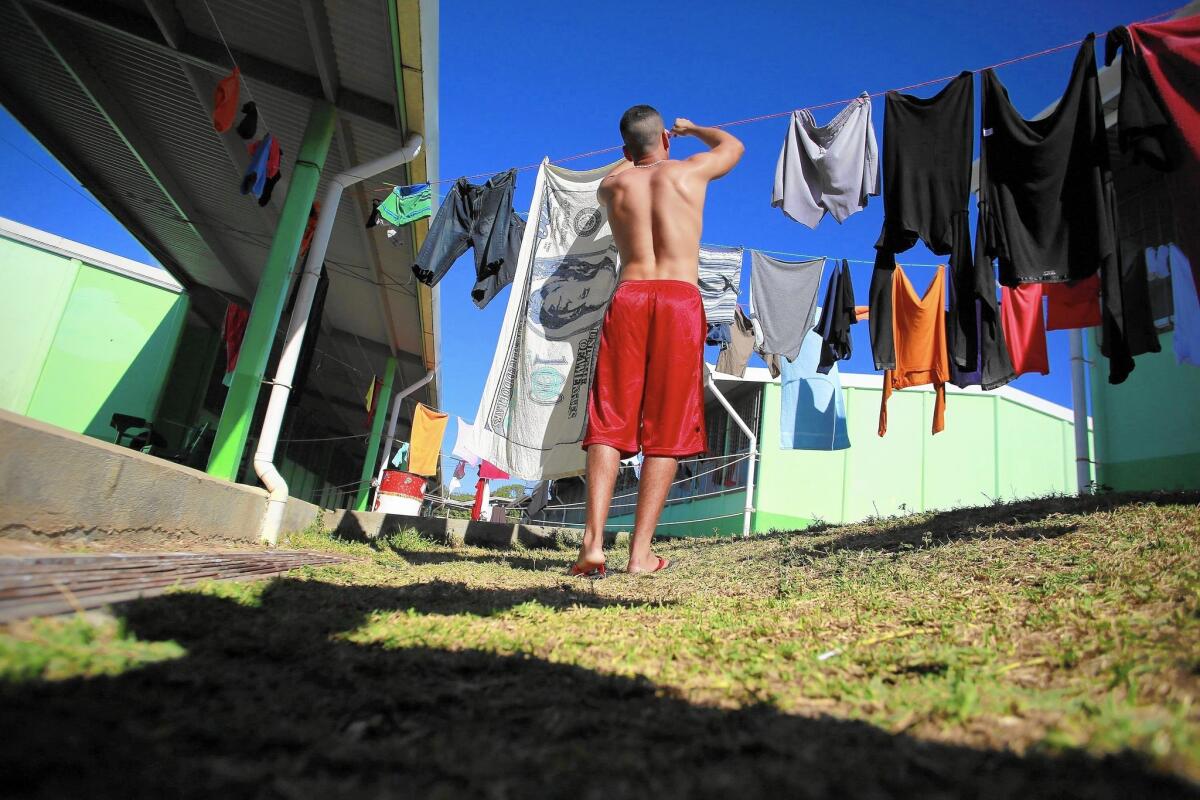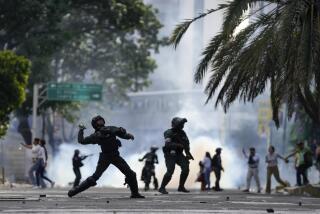U.S.-bound Cuban migrants stranded in Costa Rica camps

Reporting from SAN RAMON, Costa Rica — Julio Alvarez’s troubles with the police in Cuba started when they stopped him from selling sandwiches on the street.
Alvarez, a 35-year-old father from Cienfuegos, a city on the Caribbean island’s southern coast, patted his hands together, mimicking the bread on the fish as he described his sandwiches. He sold them to supplement his $20-a-month salary as an English teacher to support his wife, daughter and mother.
“You can’t live on that,” he said.
For five years the sandwich side business helped Alvarez and his family get by, but when the police finally shut him down, he made the same decision that thousands of other Cubans have. Instead of trying to cross the 90-mile Florida Straits to the U.S. in a raft, he chose a circuitous route that included a commercial flight from Cuba to Ecuador, with plans to travel north on a 5,000-mile route through South America to Costa Rica and on to the Texas-Mexico border.
But since leaving the communist-ruled island, Alvarez and nearly 8,000 Cubans have found themselves waylaid in temporary shelters in Costa Rica after Nicaragua closed its border to the migrants in November. After two months of diplomatic wrangling, Costa Rica, El Salvador, Guatemala and Mexico authorized an airlift to help the stranded Cuban migrants reach the U.S., but getting north remains difficult.
At a gymnasium that serves as a shelter, a white bed sheet hanging over the entrance bears a spray-painted message in Spanish: “I will not let myself lose hope.” Inside, simple wooden bunk beds with foam mattresses line the perimeter of the building. An American flag hangs off the top bunk of one bed. It’s sunny outside, but people are lined up in a dark hallway, faces aglow from smartphone screens, elbowing for a spot on the stretch of wall with the only reliable Wi-Fi signal in the camp.
Outside, Meloni Hanzlik, a confident 13-year-old girl from Havana with hazel eyes, sits with a group of adults, jumping in to make sure she’s heard. “For me and my family, we left to have a better life,” she said, “to have a good job that pays you for the work you do, for who you are.”
Hanzlik’s parents were professionals in Cuba: her father a veterinarian and her mother an artisan. But like so many of the people in this camp, from nurses and engineers to day laborers, they said that education and experience simply don’t pay back home.
“Why should my daughter stay in Cuba and study?” asked Oscar Gonzalez, 38, “For what? Misery?”
Immigration from Cuba to the U.S. started trending up in 2009, according U.S. Customs and Border Protection, but that flow crested into a wave in 2015. A rapprochement between the U.S. and Cuba announced in December 2014 sparked fears that the U.S. would change its “wet-foot, dry-foot” policy, which allows Cubans to stay if they reach U.S. soil. More than 43,000 Cubans reached the U.S. during the 2015 fiscal year, a 78% jump from the 24,278 who arrived in 2014.
That jump in migration was good business for smugglers in Costa Rica until police dismantled an operation in November that specialized in Cuban migrants. With no path forward, soon masses of Cuban migrants appeared at the border demanding to cross. Costa Rica started issuing transit visas, but as the crowds grew into the thousands Nicaragua closed its border, leaving Costa Rica with more than 7,800 stranded migrants living in 38 shelters across the country.
After talks broke down with Nicaragua before Christmas, Costa Rica, El Salvador, Guatemala and Mexico agreed to a plan to fly the migrants over Nicaragua and into El Salvador. From there, the migrants are bused from San Salvador, through Guatemala to the Tapachula border crossing in Mexico. The cost of the ticket — $555 — includes airfare, bus fare, exit and entrance visas, food and health insurance. Once in Mexico, the migrants are given 20-day transit visas to reach the U.S., but they must do so on their own.
The first airlift Jan. 12 brought 180 migrants to the U.S. border in Laredo. More flights out of Costa Rica are expected soon.
Costa Rican Foreign Minister Manuel Gonzalez said Wednesday in a statement that the next flight carrying migrants would leave Costa Rica on Feb. 4 and that there would be two flights a week in February. Leaders met in Guatemala City to discuss the airlift.
The efforts to accommodate the migration of Cubans leaving the island for economic and political reasons stand in sharp contrast with that of Central American migrants fleeing chronic violence in their home countries.
This month, 121 Central American migrants in the U.S. — many adults and children who entered the country during an increase in migration in 2014 — were detained and authorities began processing them for deportation.
“It’s surreal that there are governments negotiating the transit of migrants,” said Juan Carlos Gomez, director of the Carlos A. Costa Immigration and Human Rights Clinic at Florida International University. “How is Mexico supposed to stop some and provide transit visas to others? There’s a contradiction there.”
Gomez isn’t alone in thinking so. On Jan. 6, upon reaching an agreement for the legal transit of Cuban migrants through the isthmus, then-president of Guatemala, Alejandro Maldonado, railed against the perceived double standard between the efforts to protect Cuban migrants while Central Americans were turned away or deported.
The Cubans got the guarantee to reach the U.S. “and what does the United States say? Bienvenidos. And the Guatemalans? They throw out! 190,000 Guatemalans in two years have been thrown out of the U.S. and Mexico,” Maldonado told reporters.
The Obama administration has said several times that there are no plans to change the Cuban Adjustment Act, but this latest wave has some U.S. lawmakers, including Cuban American Republican presidential candidate Marco Rubio, calling for an end to some of the federal benefits Cubans receive when they reach the United States.
Regardless of any potential loss of federal benefits or immigration preferences, Raysel Montejo, a 42-year-old veterinarian at the camp, said that Cubans would keep trying to reach the United States.
“The only way you could make sure that Cubans don’t wake up and leave for the United States,” he said, “is if you put up a big sign that says, [Cuban leaders] ‘Fidel and Raul Castro are coming to the U.S.’”
Dyer is a special correspondent.
More to Read
Sign up for Essential California
The most important California stories and recommendations in your inbox every morning.
You may occasionally receive promotional content from the Los Angeles Times.










